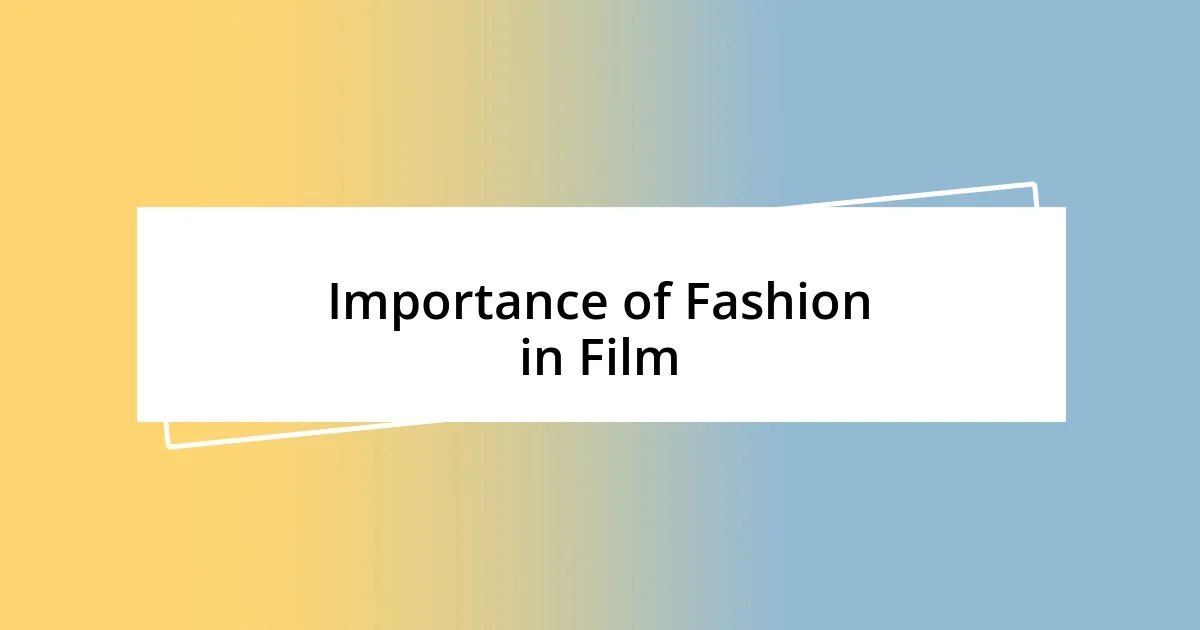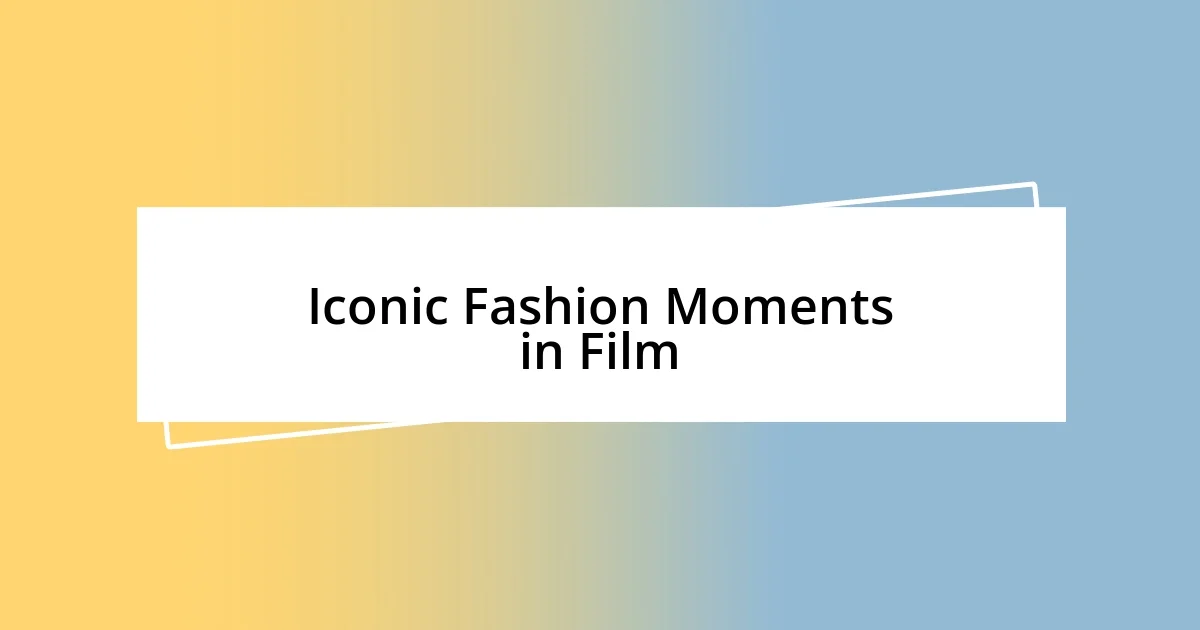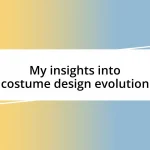Key takeaways:
- Fashion in film serves as a powerful narrative tool, reflecting societal changes and character development, illustrated by examples like “The Devil Wears Prada” and “La La Land.”
- Iconic fashion moments, such as Audrey Hepburn’s little black dress in “Breakfast at Tiffany’s,” convey deeper themes of identity and empowerment, resonating with audiences.
- The collaboration between filmmakers and designers, like Baz Luhrmann and Catherine Martin in “The Great Gatsby,” exemplifies how costume design enhances storytelling and evokes emotional responses.

Introduction to Fashion in Film
Fashion in film has always served as more than just visual appeal; it often tells a story all on its own. I vividly remember watching “Breakfast at Tiffany’s” for the first time and being captivated not just by Holly Golightly’s charm but by her iconic little black dress. Have you ever wondered how much of a character’s personality can be conveyed through their wardrobe choices?
In my exploration, I found it fascinating how films from different eras reflect not only societal norms but also the evolution of personal expression. Take the bold styles of the 1980s, for instance; they scream individuality and rebellion. I often think about how these choices can resonate with our own lives—what do our outfits say about us?
Moreover, the collaboration between filmmakers and fashion designers has transformed the industry. I remember reading about how Yves Saint Laurent designed costumes for films, merging high fashion with cinematic storytelling. Isn’t it incredible to consider how these partnerships create a lasting impact on both art forms?

Importance of Fashion in Film
Fashion in film plays a crucial role, serving as a visual language that communicates much deeper themes and emotions. I fondly recall watching “The Devil Wears Prada” and being struck by how the character’s transformation was mirrored by her evolving wardrobe choices. Each outfit seemed to tell a story of ambition, confidence, and identity. It’s astonishing how a single accessory can convey a character’s inner struggle or triumph; it almost makes you look at your own closet differently, doesn’t it?
Another significant aspect is how fashion in film can influence real-world trends. I remember the surge of interest in vintage styles after the release of “La La Land.” The vibrant colors and retro aesthetics not only captured my attention but also inspired many to embrace a nostalgia-infused look. This interplay between cinema and societal fashion trends is a reminder of the power films wield in shaping our perceptions and preferences.
Moreover, films often utilize fashion to elevate their narratives, creating iconic moments that resonate with audiences long after the credits roll. For example, think about the impact of Audrey Hepburn’s little black dress or the flamboyant styles in “The Great Gatsby.” I still find myself daydreaming about those dazzling outfits! It’s a compelling reminder that fashion in film is not just about clothing; it’s an integral part of storytelling that can evoke powerful emotions and memories.
| Aspect | Example |
|---|---|
| Character Development | “The Devil Wears Prada” showcases transformation through wardrobe |
| Influence on Trends | “La La Land” spurred interest in vintage aesthetics |
| Narrative Elevation | Audrey Hepburn’s dress in “Breakfast at Tiffany’s” created an iconic moment |

Iconic Fashion Moments in Film
When I think about iconic fashion moments in film, several scenes immediately come to mind. The vibrant red dress worn by Julia Roberts in “Pretty Woman” perfectly encapsulates the character’s transformation and empowerment. I remember watching that scene as a teenager and feeling a rush of excitement; it was a moment that made me believe fashion could be a vehicle for change in one’s life. That dress didn’t just look stunning; it represented a newfound confidence and freedom, which left a lasting impression on me.
More often than not, these fashion moments are etched in our minds, capturing the essence of an era or a character. Here are some that stand out for me:
- Audrey Hepburn in “Breakfast at Tiffany’s”: The little black dress became synonymous with timeless elegance.
- Marilyn Monroe in “The Seven Year Itch”: The white dress billowing over the subway grate became an unforgettable symbol of femininity.
- Cher in “Clueless”: Her bold and colorful outfits defined ’90s fashion, making a wardrobe full of plaid iconic.
- Leonardo DiCaprio in “The Great Gatsby”: The flamboyant suits showcased the lavish lifestyle, highlighting the opulence of the Roaring Twenties.
- Emma Stone in “La La Land”: The enchanting yellow dress she wore during the opening number captured the aspirations of a generation, melding nostalgia with modernity.
Each of these moments not only defined the characters but also resonated with audiences, allowing us to see aspects of ourselves reflected in their stories. There’s something magical about how fashion can evoke emotions and create lasting memories, don’t you think?

Evolution of Costume Design
The evolution of costume design in film is a fascinating journey that mirrors societal changes and artistic movements. Take, for example, the transition from the sumptuous garments of silent film era stars like Greta Garbo to the sleek, modern silhouettes of the 1960s. I remember being captivated by the bold and experimental designs in films like “Bonnie and Clyde.” Those costumes weren’t just clothes; they symbolized a rebellion against traditional norms, capturing the spirit of a generation. It’s intriguing how costume design can act as a powerful reflection of the time period.
As cinema progressed into the 1980s and beyond, we saw costume designers embracing eclectic styles to create characters that felt both relatable and aspirational. I think of films like “The Breakfast Club,” where each character’s outfit told its own story of individuality and belonging. Dressing up as fashion-forward teenagers for Halloween was a rite of passage for me and my friends, and even then, I understood that what we wore was a way to express ourselves. Don’t you find it remarkable how fashion can serve as a visual shorthand for personality?
In more recent years, costume design has advanced with technology, allowing for incredible innovations that enhance storytelling. The detailed attire in “Black Panther,” for instance, seamlessly blends traditional African wear with futuristic elements, creating a vivid tapestry of culture and imagination. I still recall the awe I felt while watching it; every costume seemed meticulously crafted to signify more than just style, but a rich heritage and powerful narrative. Isn’t it amazing how costume design can evoke such a strong emotional response and connect us to deeper themes?

Influence of Designers on Film
The influence of designers on film is truly remarkable. When I think about iconic films, I can’t help but recall the unique vision that costume designers bring to the table. For instance, I remember watching “The Devil Wears Prada” for the first time and being struck not just by the storyline but by the transformative power of the outfits created by Patricia Field. Each ensemble spoke volumes about the characters’ personalities and aspirations, making the film a showcase of high fashion that left me in awe.
Renowned designers like Edith Head and Hubert de Givenchy have not only shaped individual films but also set trends that permeated popular culture. Their designs contributed to a cinematic language that transcends dialogue. I remember discussing Edith Head’s work with friends during a movie night; we were all captivated by how her designs in “Funny Face” not only elevated Audrey Hepburn’s character but also influenced fashion outside the film. It’s fascinating to consider how a costume can become an enduring symbol, wouldn’t you agree?
Moreover, the collaboration between filmmakers and fashion designers has paved the way for rich storytelling. I was particularly enchanted by the creative partnership between Baz Luhrmann and costume designer Catherine Martin in “The Great Gatsby.” The lavish costumes don’t just reflect the opulence of the 1920s; they transport the viewer into that glamorous world. Seeing those outfits on screen triggered a wave of nostalgia mixed with excitement. How powerful is it, then, that a mere outfit can evoke such strong emotions and memories? It makes me appreciate the artistry behind costume design even more, knowing that it’s about so much more than just clothes.

Fashion Trends Sparked by Cinema
The impact of cinema on fashion trends is undeniable, and I’ve always found it fascinating how specific films can ignite entire movements in style. For instance, when “Breakfast at Tiffany’s” hit the screen, who couldn’t help but be enchanted by Audrey Hepburn’s little black dress? That iconic look didn’t just influence evening wear, it transformed it into a symbol of elegance and sophistication. I recall trying to replicate that iconic style for a formal event, feeling empowered and timeless, just like Hepburn did on screen.
Think about the 1990s film “Clueless.” The vibrant colors and playful aesthetics introduced us to a fresh take on teen fashion that resonated with many. I remember my friends and I eagerly swapping outfits inspired by Cher’s eclectic wardrobe, filled with plaid skirts and knee-high socks. It was more than just dressing up; we felt like we were embodying the confidence and carefree spirit of the characters. Isn’t it incredible how a film can make us feel connected to a community through fashion?
More recently, the popularity of films like “La La Land” has sparked a resurgence of classic Hollywood elegance. The dreamy costumes transported me back to a time when glamour ruled the red carpet. I caught myself longing for those vibrant colors and fluid silhouettes in my own wardrobe. Don’t you think it’s delightful how certain cinematic moments can inspire us to explore fashion in ways we might have never considered otherwise? It’s like each film offers a chance to celebrate creativity, individuality, and our shared love for style.

Conclusion on Fashion’s Impact
Fashion’s impact in film is a powerful testament to how clothing can tell a story. I once attended a screening of “Atonement,” where Keira Knightley’s character donned that striking green dress during the garden scene. Each time I see that dress, I’m reminded of how fashion can encapsulate longing and desire in a way that words often can’t. It’s as if that one ensemble defines not just a moment but an entire emotional arc. How incredible is it that an item of clothing can resonate so deeply with our feelings?
Moreover, the interplay between fashion and film cultivates cultural discussions that go beyond aesthetics. Take the style evolution in “The Hunger Games”; Katniss Everdeen’s signature look reflects themes of survival and rebellion. I vividly remember how that character inspired many, including myself, to think critically about fashion as a form of resistance. This led to conversations with friends about how our clothing choices can express our values, sparking a movement towards sustainable fashion that stemmed from a cinematic narrative. Isn’t it fascinating how the clothes we wear can become symbols of our beliefs?
Finally, fashion in film serves as a mirror to society. Films like “Paris is Burning” showcase the vibrant culture of drag and the world of ballrooms, emphasizing the importance of self-expression. I was moved after watching it, realizing that each outfit represented a fierce emotional story of identity and community. This connection between film and fashion allows us to reflect on who we are and the narratives we choose to share with the world. Don’t you feel empowered when your style echoes your journey? When fashion and film unite, they create a dynamic space that provokes thought and inspires change.














